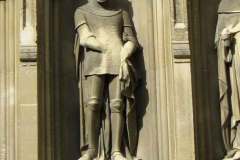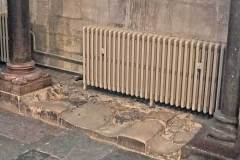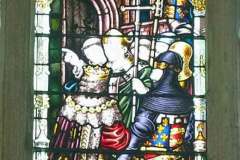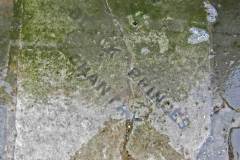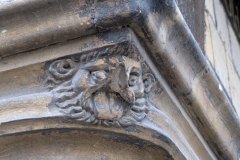(1330-1376) Prince of Wales, Military Leader, First Knight of the Garter
Edward was the eldest son of Edward III and his wife Philippa of Hainault. Called Edward of Woodstock (after his birth place in Oxfordshire), he was invested Prince of Wales at the age of 12 in 1343. With the king away at war for long periods, the prince stood in for his father and conducted royal diplomacy at a very early stage of his career. He proved his military skills and leadership in several key engagements of the 100 years’ war with France. By the age of 16 he had achieved fame at the Battle of Crecy (1346), and at Poitiers (1356) he sealed his victory by taking the French king John II captive. By this time he had been made a founder knight of the new Order of the Garter (1348). His chivalry could give way to arrogance and cruelty – at Limoges in 1370 he oversaw the massacre of 3,000 residents. He had known his cousin Joan, ‘The Fair maid of Kent’, from his earliest childhood years, and wished to marry her. This, as they were blood relatives, required permission from Pope Innocent VI. They married in 1361 at Windsor Castle but as part of the papal dispensation Edward financed the new Black Prince’s chantry – now the Huguenot chapel. Edward was only 45 when he died, in London, too early to become king as his father survived him by a year. His illness has been described variously as dysentery, cancer or multiple sclerosis.
What to see (the funeral, tomb and achievements are described separately here):
- image of Edward on the south face of the tower buttress – this is one of over 60 statues by Theodore Phyffers (Image 1) and the cost of £24 was met by the ‘Ladies of Canterbury'(!)
- evidence of an earlier altar and probable display of the Black Prince’s achievements can be seen opposite the tomb – note the very irregular slabs where pilgrims have knelt in prayer (Image 2)
- image in stained glass in the Chapter House west window showing Edward in Canterbury in 1537 with his captive king John of France following his victory at Poitiers
- evidence in the city of the location of the Black Prince’s chantry can be seen in King’s Street – this is one of the city ‘Cozens stones‘ (Image 4)
- the odd animal grotesque (Image 5) carved on the corner of High Street and Mercery Lane (now Mr Simm’s Old Sweet Shop) formed part of the Chequer of Hope Inn) has traditionally been associated with the Black Prince – it is thought to represent his cognizance (heraldic badge) and bears a resemblance to the open-mouthed lion which appears on the helm in the Prince’s achievements
Sources: see standard cathedral sources; also Cook (1990)
NOTE: to hear a Cathedral Podcast on the Black Prince click here
DL

